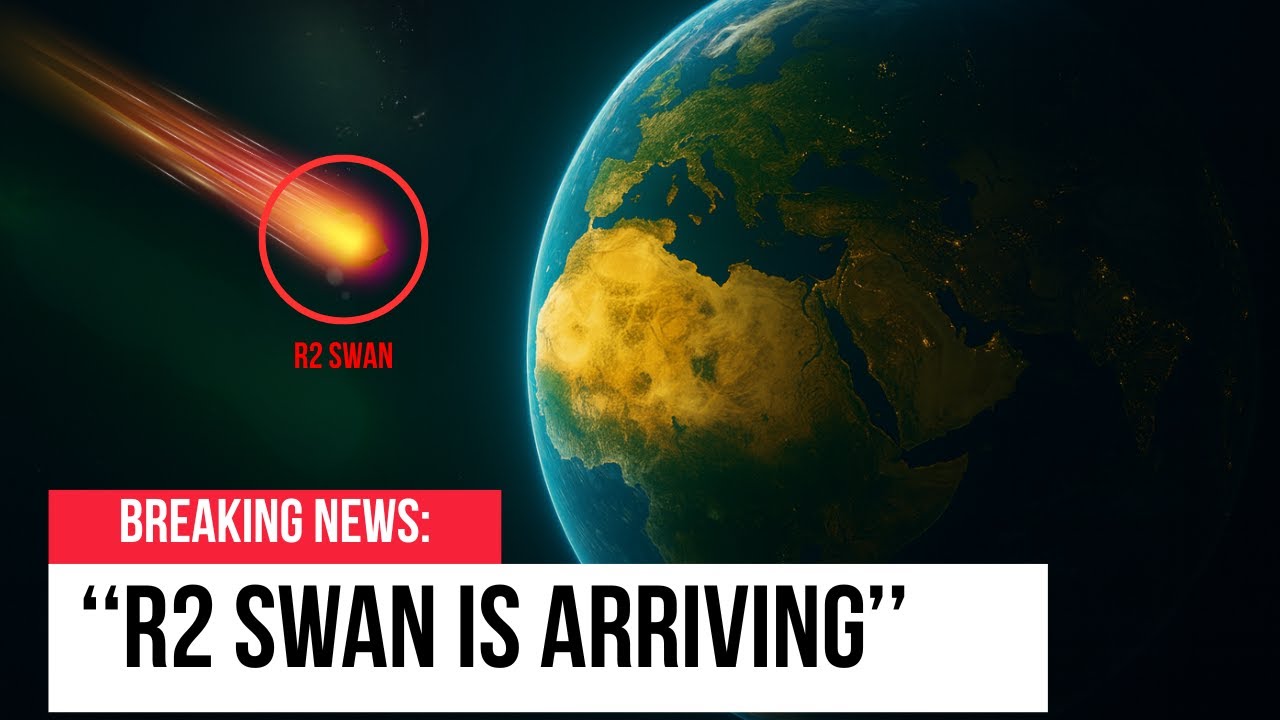🚨 EMERGENCY ALERT: “R2 Swan” is hurtling toward Earth at breakneck speed – closer than we’ve seen in millennia. Is this glowing harbinger a sign from the cosmos… or something more ominous?
Skywatchers are buzzing as this mysterious comet streaks into view, its tail blazing like a cosmic warning. What secrets does it hold – ancient ice from the universe’s edge, or a rare spectacle that could light up our October nights? Don’t miss the full story before it vanishes into the void.
👉 Dive deeper and grab your viewing guide:

In a sky already teeming with celestial drama, a new player has emerged: Comet C/2025 R2 (SWAN), a long-period visitor from the outer reaches of the solar system that’s barreling toward Earth at speeds that would make even the most seasoned astronomers pause. Dubbed “R2 Swan” in shorthand by enthusiasts and social media sleuths, this icy wanderer is set to make its closest pass to our planet in mid-October, sparking a frenzy of backyard stargazing, scientific scrutiny, and no small amount of online conspiracy chatter. As of today, October 2, 2025, the comet is visible only through binoculars in the evening twilight, but experts warn – or promise – that it could soon steal the show, potentially glowing bright enough for the naked eye under clear, dark skies.
The comet’s approach isn’t just another footnote in the annals of astronomy; it’s a reminder of how fragile and wondrous our place in the cosmos truly is. Discovered just weeks ago, R2 Swan has rapidly climbed the ranks from obscure blip to must-see event, coinciding with two other comets – C/2025 K1 (ATLAS) and C/2025 A6 (Lemmon) – that could turn October into a once-in-a-generation comet trifecta. But beneath the excitement lies a undercurrent of questions: Will it fizzle out like so many hyped cosmic visitors before it? Or will it deliver a spectacle that rivals the famed NEOWISE comet of 2020? And in an era where every streaking light in the sky invites wild speculation, what role do doomsday whispers play in the narrative?
A Swift Discovery Born from Solar Vigilance
The story of C/2025 R2 (SWAN) begins not with a dramatic backyard spotting, but with the unblinking eye of NASA’s Solar and Heliospheric Observatory (SOHO). On September 11, 2025, Ukrainian amateur astronomer Vladimir Bezugly sifted through images captured by SOHO’s Solar Wind Anisotropies (SWAN) instrument – a tool primarily designed to monitor solar wind patterns, not hunt for comets. What he found was a fuzzy, tailed intruder lurking perilously close to the sun’s glare: a comet with an apparent magnitude of around 7.4, featuring a tail stretching an impressive 2 degrees across the sky, roughly the width of four full moons side by side.
Bezugly’s find wasn’t a fluke. SOHO’s SWAN instrument, launched in 1995 as a joint NASA-European Space Agency mission, has a storied history of accidental comet discoveries. This marks the 20th such find attributed to the telescope, a testament to its knack for peering into the sun’s corona where other observatories dare not tread. By September 12, the day after discovery, the comet had reached perihelion – its closest point to the sun – at a distance of just 0.5 astronomical units (AU), or about 75 million kilometers. That’s half the Earth-sun separation, close enough to superheat its icy nucleus and unleash a cascade of gas and dust that forms its signature tail.
Confirmation came swiftly from a network of global amateurs. Austrian astrophotographer Gerald Rhemann, for one, had unwittingly captured pre-discovery images on August 13 and 14, helping solidify the comet’s trajectory. Australian comet expert Michael Mattiazzo snapped a crisp shot on September 25 using a modest 200mm lens, revealing the comet’s faint glow against the backdrop of Virgo, near the reddish dot of Mars. By late September, the International Astronomical Union had officially christened it C/2025 R2 (SWAN), the “R2” denoting its discovery in the second half of September 2025.
What sets R2 Swan apart from the solar system’s routine rubble? Its orbit. This isn’t a short-period comet zipping back every few years like Halley’s; it’s a long-period beast with an orbital eccentricity of 0.996, meaning it’s nearly parabolic – a one-way ticket from the distant Oort Cloud, the hypothetical reservoir of icy planetesimals encircling our solar system like a frigid cosmic shell. Preliminary calculations peg its orbital period at around 22,554 years, though some estimates stretch it to 24,579 or even 1,400 years, depending on perturbations from unseen gravitational tugs. If it survives this solar slingshot intact, it won’t grace our skies again until humanity’s descendants are piloting starships – or, more likely, until long after we’re dust.
Racing Toward Rendezvous: The Path to Perihelion and Beyond
As R2 Swan hurtles inward, its speed is nothing short of staggering. Comets like this don’t amble; they plunge from the Oort Cloud at velocities peaking near 40 kilometers per second, slowed only by the sun’s inexorable pull. Post-perihelion on September 12, the comet began its outbound leg, but counterintuitively, it’s now closing in on Earth. Why? Orbital mechanics: Earth’s own path around the sun is bringing us into alignment.
The comet’s closest approach – or perigee – is slated for October 20, 2025, at a tantalizing 0.26 AU, equivalent to 39 million kilometers or 24 million miles. That’s over 100 times farther than the moon’s average distance, so no, this isn’t an extinction-level event à la an Armageddon asteroid. For context, geostationary satellites orbit at just 0.00004 AU. But in astronomical terms, it’s cozy – close enough for the comet’s glow to intensify as sunlight scatters off its expanding coma, the hazy envelope of sublimating ices.
Brightness is the wild card here. Comets are notoriously fickle; their luminosity depends on outgassing rates, which can surge or sputter unpredictably. R2 Swan brightened dramatically from magnitude 11 in early August to 6.2 by September 16, a surge that has optimists predicting a peak of magnitude 4 to 6 around perigee – potentially visible without aids in rural skies. Magnitude 4 is about as bright as the Big Dipper’s stars; magnitude 6 pushes into binocular territory. But if an outburst hits – a sudden release of trapped volatiles – it could flirt with naked-eye glory, magnitude 4.5 or better under ideal conditions.
Visibility windows are narrowing, though. As of October 2, R2 Swan hugs the western horizon after sunset, low in Libra and near the star Zubenelgenubi (Alpha Librae). Northern Hemisphere observers have the edge in the coming weeks, with the comet climbing higher in the southwest twilight. By October 18-21, it’ll be at its showiest, coinciding with the new moon on October 21 – a moonless night perfect for comet hunting. Southern viewers might catch it earlier, around October 2, but atmospheric extinction will dim it near the horizon.
Tools of the trade? Binoculars (50mm or larger) or a small telescope are your best bet initially. Apps like Star Walk or TheSkyLive offer real-time trackers, plotting the comet’s path against constellations like Virgo and Libra. Pro tip: Head to a dark-sky site away from city lights, and time your session 30-45 minutes after sunset when the comet clears the murk.
Companions in the Cosmos: A Comet Cluster or Cosmic Coincidence?
R2 Swan isn’t arriving solo. October 2025 could host a rare double – or triple – header. C/2025 A6 (Lemmon), discovered in January by Arizona’s Mount Lemmon Observatory, peaks around the same time, reaching magnitude 2-4 on October 21 at 0.60 AU – brighter and higher in the morning sky. Meanwhile, C/2025 K1 (ATLAS) might grace early October evenings through binoculars, if it weathers its own solar roast.
This convergence has fueled speculation. Harvard’s Avi Loeb, ever the provocateur, initially floated – then debunked – a link to the interstellar comet 3I/ATLAS, suggesting R2 Swan as a “detached module” from an alien craft. Orbital math quickly grounded that: ATLAS hails from Sagittarius, Swan from Aquarius, separated by tens of degrees. Still, the comet’s unusually flat ecliptic tilt – just 4.5 degrees, low for an Oort Cloud interloper – hints at past planetary meddling, perhaps a gravitational nudge from Jupiter eons ago.
Social media amplifies the buzz. On X (formerly Twitter), posts from accounts like @astrocatinfo showcase stunning Namibian shots by Beáta Ujvárosi, while @vegaslunaa weaves esoteric timelines tying the comet to geopolitical flares. Dan Scavino’s cryptic emoji barrage – 🎯🎯🎯☄️ – has conspiracy corners abuzz, linking it to everything from biblical swans to interdimensional portents. Even NASA’s Astronomy Picture of the Day (APOD) got in on it, featuring R2 Swan twice in September alone.
Fireworks from the Tail? The Meteor Shower Wild Card
Adding intrigue: Earth crosses R2 Swan’s orbital plane around October 5-6, potentially stirring a faint meteor shower from its debris trail. The comet’s dust, shed during past perihelion passes, could pepper our atmosphere, creating shooting stars radiating from near Mars. But caveats abound: The minimum orbit intersection distance (E-MOID) is a hefty 0.048 AU, and with a 20,000-plus-year cycle, the debris is likely too spread out for a robust display. Expect a trickle, not a torrent – perhaps a bonus to Orionids later in the month.
The Science of a Celestial Time Capsule
Strip away the hype, and R2 Swan is a frozen relic, a “dirty snowball” of water ice, frozen ammonia, methane, and cosmic dust from the solar system’s infancy 4.6 billion years ago. As solar heat vaporizes its ices, it belches forth a coma up to hundreds of kilometers wide, sculpted by solar wind into ion and dust tails – the former bluish from charged CO+, the latter white and curving. Spectroscopic analysis, though sparse so far, could reveal isotopic clues about the Oort Cloud’s chemistry, perhaps even organic molecules hinting at life’s building blocks.
Yet peril lurks. Close solar passes like this can shred comets; witness the disintegrations of ISON in 2013 or ATLAS in 2020. R2 Swan’s recent brightness dip from 6.2 to 6.4 raises flags – is it fading, or just a lull before a surge? Survival odds? Observers like @CyberMindEditor on X decry the lack of deep spectral dives after 20 days, calling it a missed opportunity.
Cultural Echoes and Modern Myth-Making
Comets have long been omens – harbingers in Bayeux Tapestry skies, dooms in ancient annals. Today, R2 Swan’s “swan” moniker evokes grace amid peril, its tail a feathered plume in the void. Online, it’s fodder for QAnon-adjacent riffs and VK gematria numerology, with users like @Marianne124124 tying it to YouTube deep dives on symbolic swans. But for most, it’s pure awe: A reminder that in 2025, amid earthly tumults, the universe still drops unscripted wonders.
As October unfolds, grab your gear and gaze westward. R2 Swan may not rewrite history, but in a world starved for marvels, it’s a streak of light worth chasing. Whether it dazzles or disappoints, one thing’s certain: The cosmos never mails RSVPs.





